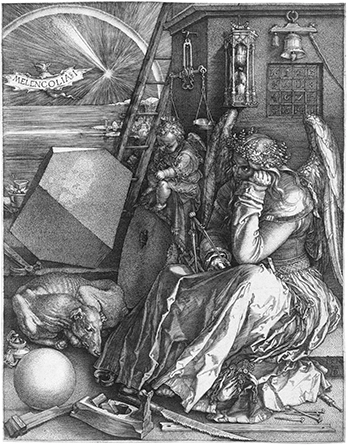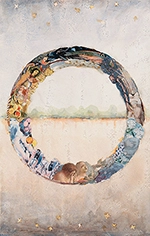ARAS Connections: Image and Archetype - 2020 Issue 2

Perhaps like many of you, I have found myself watching a fair amount of television during the pandemic. I recently finished all four mediocre seasons of a space odyssey saga entitled Expanse that takes place a few hundred years in the future. I was “spaced out” by the fourth season when the giant space ship, the Behemoth (named for Meliville’s Moby Dick or for the Polish extreme metal band from Gdańsk?), journeys into a weird energy field and suddenly decelerates rapidly causing the occupants floating inside to be slammed to the floor or into their chairs by the precipitous increase in gravity.
It occurred to me that the Behemoth’s slamming to a halt in its space travel with such dramatic impact on its passengers is not unlike our spaceship earth’s rapid deceleration which has been an unexpected godsend to some of us and a huge loss to many more in terms of life, health, and security. The pandemic has given pause to reflect on the state of our planet and hopefully given enough of us a glimpse of a slower paced, less consumptive life in which we can even occasionally hear the voices of nature. Our two contributors to this edition of ARAS Connections both know a tremendous amount about the stirrings in depth that this sudden deceleration has brought to us. Paul Brutsche, one of the foremost Jungian scholars of symbolic imagery, has contributed an extraordinary gift in the form of “A Meditation on Melencolia in a Time of Pandemic." Melencolia certainly knows about the sluggish deceleration that goes along with its taking hold of the soul. And, as Brutsche brilliantly suggests, Dürer’s etching from 500 years ago seems as relevant today as it was when Dürer first created it. There is something timeless and truly archetypal about the melancholic state of crippling stagnation, dread and despair that has been upon us. Brutsche also points to the other side of melancholia in Dürer’s etching in which we get a glimpse of renewed creativity and expanded horizons. As Mary Wells Barron says, "The depth, beauty, erudition and soul of Paul Brutsche's discussion of Albrecht Durer's MELENCOLIA are moving in a way that is only possible through the true conjunction of word and image.”
Jeffrey Kiehl picks up the thread of dire threat and the need for renewal in his consideration of the environmental crisis of climate change. As a former climate change scientist and now Jungian analyst, Kiehl is uniquely qualified to probe both the science and the psyche of our current crisis. He originally presented this paper at the 2019 Art and Psyche Conference in Santa Barbara, California. We are lucky to share with you his presentation and its accompanying imagery of the mandala which occurs spontaneously throughout nature as well as in the human psyche when it is most in need of compensation and healing.
Dr. Kiehl’s illustrations of his paper are exceptional and his final video of the mandala at play in natural and human creativity is among the most beautiful displays of mandala imagery I have ever seen.
https://www.youtube.com/watch?v=iBYbdmYY72w
A Meditation on Albrecht Dürer’s Melencolia in a Time of Pandemic

Although this engraving by Albrecht Dürer is 500 years old (1514), it can reflect something that is also experienced in the current corona virus crisis. One could say that the Covid-19 disease forces us to a collective experience of melancholy. The psychological situation into which this has brought us, the challenges and practical measures that became necessary to cope with them collectively and individually, as well as their possible historical significance, seem to me to be expressed symbolically in this engraving.
A superficial certainty has been lost. Suddenly, insecurity and doubt have taken the place of previous security and confidence. The clarity of our familiar outward circumstances has given way to a complex reality of questions, doubts and longings. The world is no longer as tightly knit as it used to be. It is called into question. Suddenly, unpleasant questions arise about meaning, questions about what is important in life, what is ultimately important. When life is threatened and one is not quite sure whether one is caught up by the deadly virus or is spared, inner, existential questions open up. The world presents itself as a jumbled multitude of isolated things. Suddenly any big picture is missing. That is why it is so strangely difficult to really concentrate in such a time.
Read A Meditation on Albrecht Dürer’s Melencolia in a Time of Pandemic by Paul Brutsche in its entirety here.
The Mandala as Portal to Healing

Living in Chaos
We find ourselves immersed in chaos. The current pandemic due to the appearance of the COVID-19 virus is causing major disruptions to people’s lives with a tragic number of deaths. The disintegration of everyday life under lockdown and sheltering-in policies has led to massive unemployment and collapses in local and global economies. People feel helpless in the midst of an invisible invader that rode into our lives like the apocalyptic horsemen of pestilence and death. Yet, these are not the only horsemen riding during these times. Climate chaos with all of its associated disruptions remaining ever present. This horseman, who has been riding for decades, is not going away until we turn and face it directly. We are tasked with being amidst immense chaos and working with it [Kiehl, 2016a].
Spirit of the Times
The threat of the climate horseman began with the Industrial Revolution and burning fossil fuels. It is a threat that has been understood and forecast for many decades. Our reliance on fossil fuels has created an imbalance between the flow of the Sun’s energy available to Earth and the energy our planet emits out to space. Burning fossil fuels causes continual increases in carbon dioxide levels in the atmosphere, which increases Earth’s greenhouse effect and causes the planet to warm. As long as we burn fossil fuels, we will continue to increase the amount of carbon dioxide in the atmosphere and inhibit the planet’s ability to stay cool. The end result of 150 years of this is a warmer planet and acidification of our oceans. This massive warming has led to additional problems, including melting of polar sea-ice and of Greenland and Antarctic ice sheets with an associated rise of sea level, intensification of storms with associated flood damages and coastal storm surges, intensification of hurricanes and heat waves, and shifts in global wind patterns leading to unusual weather phenomena.
Read The Mandala as Portal to Healing by Jeffrey Kiehl in its entirety here.
Art in a Time of Global Crises presented by ARAS and Art and Psyche

ARAS and the Art and Psyche Working Group, in collaboration, have developed a new project, "Art in a Time of Global Crisis: Interconnection and Companionship," as an international outreach through art. Our goal is to create a network of mutual support through art during this difficult time.
Colleagues and friends from around the world, representing various cultures, geographical locations and life-styles, have been invited to contribute artistic images with commentaries that represent companionship, resilience and hope in the face of threat, fear and struggle.
Please join us for our daily image postings here. You can even sign up to have these images sent directly to your inbox.
Contents
Become a Member of ARAS!
Become a member of ARAS Online and you'll receive free, unlimited use of the entire archive of 17,000 images and 20,000 pages of commentary any time you wish—at home, in your office, or wherever you take your computer.
The entire contents of three magnificent ARAS books: An Encyclopedia of Archetypal Symbolism, The Body and The Book of Symbols are included in the archive. These books cost $330 when purchased on their own.
You can join ARAS Online instantly and search the archive immediately. If you have questions, please call (212) 697-3480 or email info@aras.org
We Value Your Ideas
As our newsletter grows to cover both the ARAS archive and the broad world of art and psyche, we're eager to have your suggestions and thoughts on how to improve it. Please send your comments to info@aras.org. We look forward to your input and will reply to every message.
Subscribe
If you're not already a subscriber and would like to receive subsequent issues of this newsletter by email at no cost, e-mail us at newsletter@aras.org.
